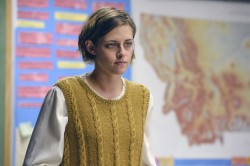Cinema | December 7th, 2016

Master filmmaker Kelly Reichardt’s “Certain Women,” based on stories by Maile Meloy, shares the quiet fortunes and misfortunes of three protagonists and the friends, family, and strangers in orbit around them.
Set in Montana, the film moves at the director’s deliberately measured pace, a technique that suits Reichardt’s alliance with the western, the genre that perhaps best describes her body of work.
As taciturn, secretive, and enigmatic as her best films, “Certain Women” withholds explanations and confessions, instead trusting the viewer to draw conclusions and fill in blanks.
In a “New York Times Magazine” profile, Alice Gregory argues the case for Reichardt as a maker of westerns, writing that her “shots are rife with the genre’s archetypal motifs — horses, trains, buttes — and the quiet stories she tells, of lonesome, semi-nomadic searchers struggling to maintain dignity in the face of seemingly insurmountable odds, fill the screen as forcefully as any film that John Wayne was ever in.”
Visions of John Ford ripping pages of dialogue out of his shooting script could as easily be transposed to Reichardt, who also understands the value of communicating in pictures instead of words.
During the movie’s opening sections, in which attorney Laura Wells (Laura Dern) demonstrates the patience of a farmer with desperate, needy, and unstable client Fuller (Jared Harris), Reichardt uncorks a sly comic sensibility suffused with Coen-like observations. Laura’s exasperation – Fuller idiotically refuses to accept her counsel until it has been corroborated by a male lawyer – is no match for her compassion, even if Dern’s vast range of nonverbal expressions suggests that she wonders how in the world she ended up right in the middle of Fuller’s mess, which comes complete with an armed standoff.
In another story, Gina Lewis (Michelle Williams) and her husband Ryan (James LeGros) visit Albert (Rene Auberjonois), hoping to convince the failing, elderly man to part with a substantial pile of sandstone blocks that Gina would like to use in the construction of her new home. Gina’s bitter relationship with her teenage daughter Guthrie (Sara Rodier) is exacerbated by Ryan, who annoys Gina by defending Guthrie. According to the director, Williams, one of Reichardt’s regular collaborators, “was so up for not caring if her character was likable,” but Gina’s iron determination to build an idealized place of domestic togetherness reveals a more sympathetic dimension.
While the veterans Dern and Williams bring expected nuance to their characters, it is breakout performer Lily Gladstone who resides at the heart of the film’s most fully realized storyline. Gladstone plays a lonely ranch hand named Jamie (listed only as “The Rancher” in the credits) who wanders into a night class on school law facilitated by Beth Travis (Kristen Stewart). Jamie establishes a tentative friendship with Beth, and Reichardt and Gladstone perfectly communicate Jamie’s vulnerability and longing.
While the stories are only loosely connected, Reichardt thematically links these individuals through their determination and stoicism, qualities echoed by Christopher Blauvelt’s lovely 16mm photography of the Big Sky landscapes, wide open spaces, and long stretches of highway that separate the small towns and the women who live in them.
December 16th 2025
December 9th 2025
December 2nd 2025
November 24th 2025
November 18th 2025
_(1)__293px-wide.jpg)
_(1)__293px-wide.png)
__293px-wide.jpg)

_(1)__293px-wide.png)
